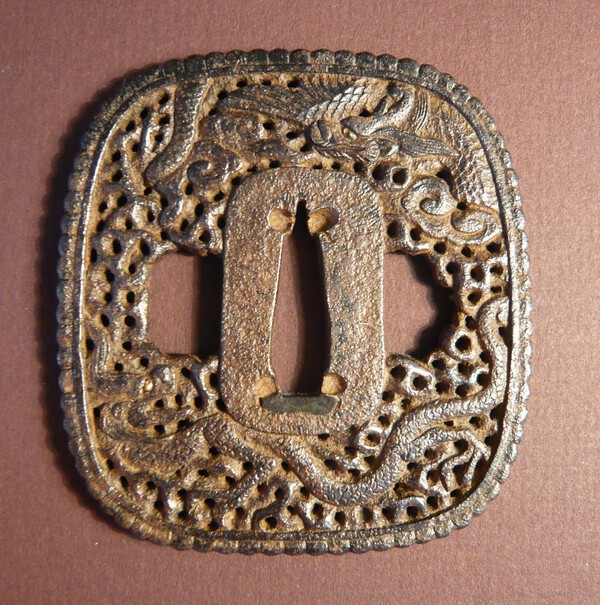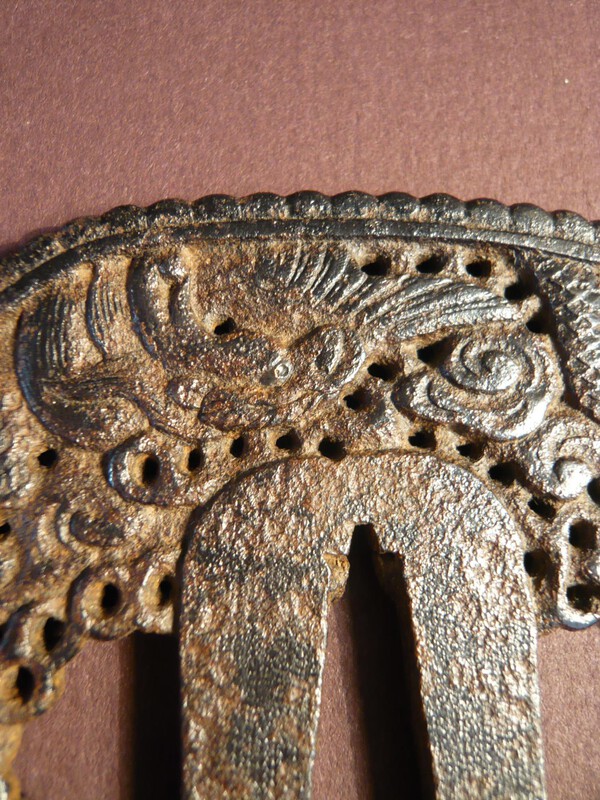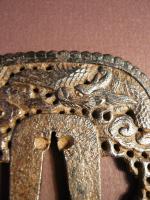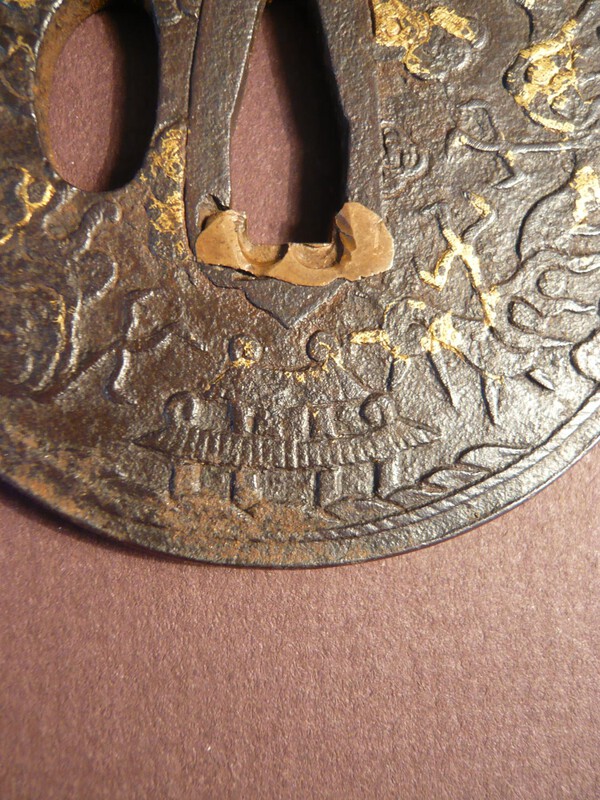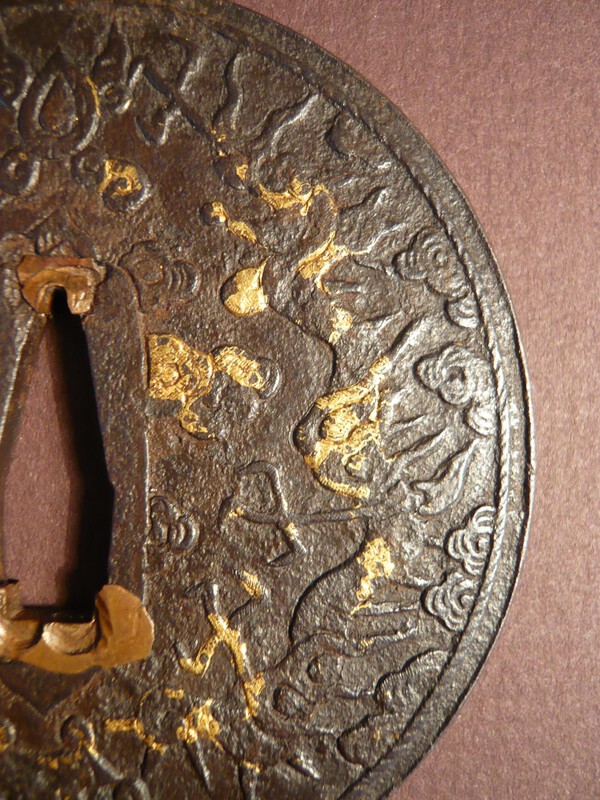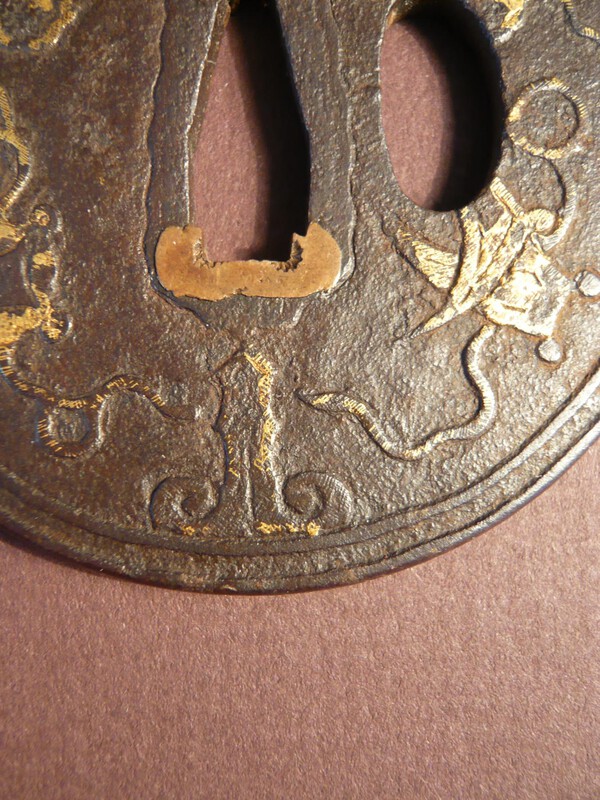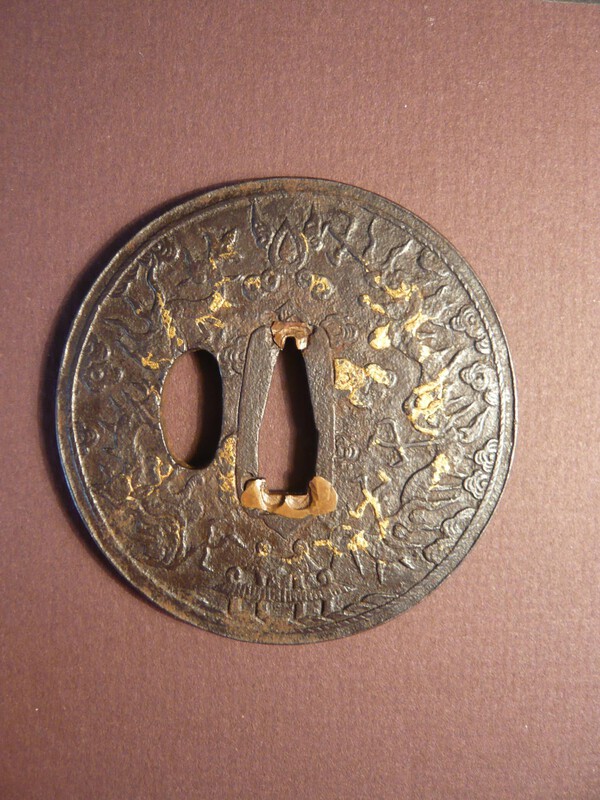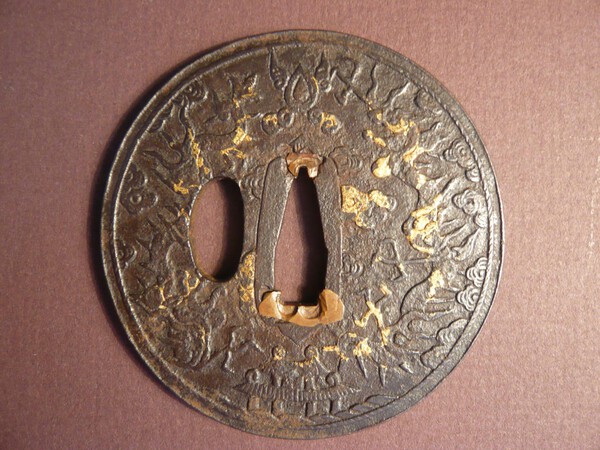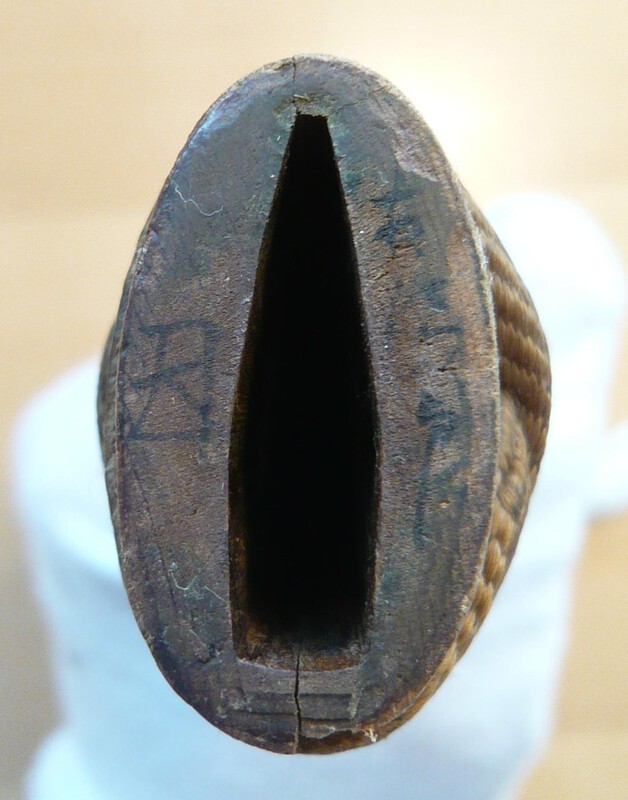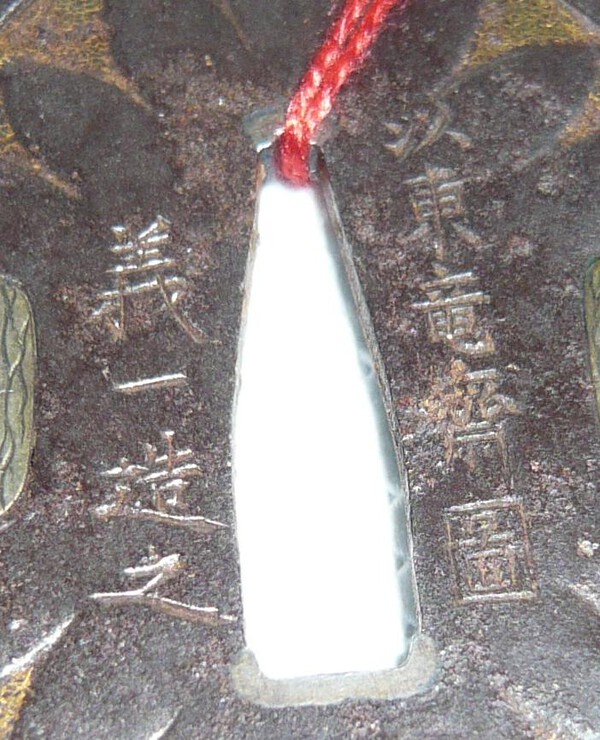
Higo-san
Members-
Posts
707 -
Joined
Everything posted by Higo-san
-
Early Tosho Tsuba From The Eckhard Kremers Collection
Higo-san replied to Higo-san's topic in For Sale or Trade
Tom, thank you for the kind words and a warm welcome. It is very difficult to determine the exact age of tosho tsuba - I think 15th century is a good guess; however 16th century is also possible. Best, Chris -
Early Tosho Tsuba From The Eckhard Kremers Collection
Higo-san replied to Higo-san's topic in For Sale or Trade
-
Dear all, I have a very beautiful early tosho tsuba for sale which came from the Eckhard Kremers collection. I bought this piece for study reasons and have very much enjoyed it's fantastic iron. The tsuchime is very rich and the deep black color absolutely stunning. The only design is a hanabishi mon done in ko sukashi. There is one hitsu ana which has been closed with (I believe) lead. Diamater is 8.2 cm x 8.2 cm an thickness is 0.27 cm. This tsuba comes with a dai inscribed by Eckhard as "Ko-tosho, hanabishi". Asking price is a modest USD 990.00 (including PayPal) plus shipping! Shipping is: Germany USD 5.00 Europe USD 10.00 Worldwide USD 15.00
-
For all those who could not get a copy from Andi B.... This guy has some brand new copies available for sale, too: http://www.nihonto.eu/de/buecher/fachliteratur/++/art_id/22/table/books_articles/
-
An interesting piece, John! I would have thought that one to be Ko-Kinko. But this confusion may also be another proof for how much early Japanese kinko craftmanship was related to Chinese craftmanship...
-
Peter, again, thank you very much for this interesting question - my comment above was not meant as an offence to you. As I said, I am not an expert on the field of Nanban tsuba - therefore, asking John as an authority on this field would have been an easy way out for me. But since John does not benefit from this sale, I felt it kind of wrong to let him do the work for me. So, I made up my own mind and came up with the criteria above. I was glad when John decided to comment without having been asked and - at least - confirmed my general approach. Coming back to your question (which is a valid and good question IMO): it is difficult to say whether or mit the hitsu ana was added later on or not. I believe that it may have been added later: the sekigane show that this tsuba has been refitted at some point to a smaller blade. At that time, the hitsu ana could have been added and parts of the original plate and design have been lost since then. Again, this may also have been part of the original design which was intended to look altered like those Nanban tsuba coming from abroad. The shape of the nakago ana was definetely intended to look sort of occasional and therefore tried to immitate tsuba coming from abroad. As my wording already indicates, I still do not believe that this was done by a Chinese artist. Uncommon nakago ana were also used e.g. by the Umetada school. But it in the end, it remains again a lot of gut feeling. Best, Chris
-
Ford, thank you for your analysis - this confirms my feeling! Rich confirmed it even further! John, thank you for your kind words. Best, Chris
-
-
Dear gentlemen, I would very much appreciate your opinion on this tsuba (it came from that source: http://www.nihontoantiques.com/archive/gallery.htm- I am thinking about selling this one in order to find a matching one for the koshirae). Facts first: - measurements: 7.8 cm x 7.1 cm x 0.5 cm (on the raised rim) - the nakaga ana has been reshaped recently (clearly visible due to (i) the lack of patina in comparison to the kozuka and kogai ana and (ii) the different filing) - the kozuka and kogai ana do not look like they have been reshaped recently or have been added later - the kiri mons have been stamped on the tsuba (most probably the very same stamp was used for all twelve kiri mon) And now my thoughts on this tsuba: The tsuba seems to have been cast, then hammered and finally stamped. We find this kind of casting technique on early soft metal tsuba (e.g. Kagamishi tsuba); also, many schools used stamps for early decorations on tsuba (like theTenpo tsuba though these were made of iron). Therefore, one may think that this tsuba is rather old - e.g. Momoyama period. On the other hand, the finish looks somehow "made to look old" to me (hard to describe...). So this tsuba could as well be gendai. Finally, I will be happy to hear your thoughts on this tsuba! Best, Chris
-
John, I already thought about asking you on your educated opinion on this issue but I did not want to urge you into a discussion... Therefore, thank you very much for your highly appreciated contribution to this topic! Best, Chris
-
Peter, thank you very much for your question! I am not an expert on Nanban tsuba but I would say that both tsuba were made in Japan (which is - despite their Name - also true for most Nanban tsuba that we see around on the market). I tend to say that the first tsuba is actually a Hizen tsuba because of the following aspects: - the design is neither typical for Indian or Chinese tsuba made for the Japanese market nor is it typical for those type of tsuba called Nanban that were made in Japan (No. 2 is rather typical for those IMO) - the whole design has a Chinese legend flair (similiar to the Choshu or Jakushi landscapes) but uses techniques and symbols which show a certain stage of tsuba craftmanship evolved throughout the centuries (just like Choshu and Jakushi tsuba do) - the iron plate is carefully forged and the gold application has an educated appeal which I would not expect from Nanban tsuba (not saying that these do not have their very own appeal) Taking all these factors together, one may identify the first tsuba as a Hizen tsuba. But it will always remain a lot of gut feeling in the end ! Best, Chris
-
2) Nanban tsuba Design of different dragons; unfortunately a little bit rusty.... diameter: 7.8 x 7.8 cm asking price is USD 240. Best, Chris
-
-
Dear fellow board members, I would like to part with two nanban tsuba that have been in my collection for quite a long time now. All prices include PayPal fees and worldwide shipping! 1) Nanban or maybe Hizen tsuba Design of a temple with cloud dragons chasing a tama pearl on the obverse and botan flower, Ken and probably a paper dragon on the reverse side. It is a fantastic and powerful design! diamter: 7.0 x 6.9 cm asking price is USD 290.
-
Dear fellow board members as the (lucky) new owner of this Sendai Kaneyoshi (http://www.nihontoantiques.com/g104.htm), I am on my way thorugh all the details of the sword and it's koshirae. What is still keeping me busy, is the mei on the tsuka. I was once told by some fellow collectors that a tsuka mei may not only refer to the person who actually made the tsuka but may also give a reference to the blade for which the tsuka was made. Even though that this second alternative may not be the case with this tsuka mei, I am still trying to find out which workshop or craftsman did the tsuka. Maybe someone from the board can assist on this issue? I have also attached two pictures of the menuki which I believe to be Waki Goto works (and which originally may not have belonged together). All the best, Chris P.S.: beautiful new layout BTW !
-
Hi all, there is a large auction coming up here in Germany in December at Van Ham. Here is the link: http://www.van-ham.com/kataloge-ergebni ... kunst.html Best, Chris
-
Hi Stephen, looks like a beautiful Kaga Yoshiro tsuba; more common are those which had some kind of mon design - however this piece clearly shows the typical brass inlays and iron surface; plus there are other sukashi tsuba like this one recorded e.g. in the Moslé collection. Great item which could well be Momoyama. Best, Chris
-
Here is just another very similiar example with a completely different attribution: https://www.bonhams.com/auctions/22248/lot/1208/
-
Many thanks for your help, gentlemen! I should have noticed the Kanji for Toryusai (東竜需); it may well be that the signature means that this tsuba was made by the order of Muneyoshi using a probably well-known Tanaka design. Great info - thanks alot!
-
Dear fellow board members, could someone assist translating this signature for a friend of mine? I can read MUNEYOSHI on one side and YOSHIKAZU KORE SAKU on the other side - seems like Yoshikazu is the maker but what does the reference to Muneyoshi and the rest of the signature mean? Thanks for your help! Chris
-
My best guess is also Tosa Myochin !
-
Thanks for the citation, Peter. The meaning of the Chinese/Japanese version seems completely different than the idea of the ancient version by Aesop (since a squirrel can easily reach the grapes while they would remain out of reach for the fox). Therefore the similarity may well be a mere coincedence. Best, Chris
-
I was really happy when I read the name of your topic, Grev! I am still thinking about the scene shown on this beautiful tsuba; the legend about the fox and the grapes (vine) is quite well known at least in some parts of the western world (I myself grew up with this story in my childhood). But I am still wondering whether this legend made it's way to Japan (together with other nanban influences) or if it was even the other way round... Nevertheless, all the best for you and your new tsuba! Chris
-
It looks like a work from the Kawaji school from Choshu. Please compare an almost identical signed daisho on this site: http://www.choshuya.co.jp/1/0802/member ... ttings.htm. Best, Chris
-
Just another idea: Kamiyoshi Fukanobu.




















